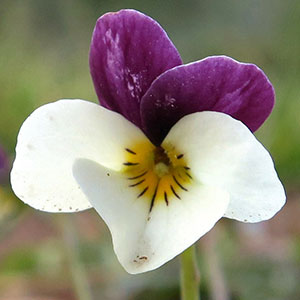Viola trinervata
Viola hallii
3-nerve violet, desert pansy, Rainier or sagebrush or three-nerve violet, Rainier violet, sagebrush violet, three-nerve violet
Hall's violet, Oregon violet, wild pansy
1–4, decumbent, ascending, or erect, ca. 1/2 subterranean, glabrous, from single, vertical, deep-seated caudex.
1–3, decumbent or ascending to erect, ca. 1/2 subterranean, glabrous, clustered on single, short, vertical, deep-seated caudex.
basal and cauline;
basal: 1–7, palmately compound, leaflets 3–5;
stipules adnate to petiole, forming 2 linear-lanceolate wings, unlobed, margins entire, apex of each wing free, acute;
petiole 4.5–15 cm, glabrous;
blade reniform or ovate to ± orbiculate, 2–5 × 2.5–5 cm, coriaceous, base tapered, leaflets cleft or dissected into 2–3 elliptic, lanceolate, or oblanceolate lobes 2–7 mm wide, margins usually entire, eciliate, apex acute, mucronulate, surfaces glabrous (± glaucous), abaxial surface usually with prominent vein parallel to each margin;
cauline similar to basal except: stipules lanceolate;
petiole 1–5.5 cm;
blade 1–3 × 2–4.5 cm.
basal and cauline;
basal: 1–4, palmately compound, ± 2-ternate or 3-ternate, leaflets 3;
stipules adnate to petiole, forming 2 linear-lanceolate wings, unlobed, margins entire, apex of each wing free, acute;
petiole 5–8 cm, glabrous;
blade ovate to deltate, 2.8–6 × 2.6–6.5 cm, ± coriaceous, base tapered, ultimate lobes narrowly elliptic, lanceolate, or oblanceolate, 1–7 mm wide, margins entire, ciliate or eciliate, apex acute, mucronulate, surfaces glabrous;
cauline similar to basal except: stipules usually lanceolate, sometimes broadly ovate, ± leaflike, margins toothed;
petiole 1.3–6 cm;
blade 2–4.8 × 1.2–5.5 cm.
1.1–7 cm, glabrous.
2.5–11 cm, glabrous.
sepals lanceolate, margins eciliate, auricles 0–1 mm;
petals: upper 2 often overlapping, dark reddish violet on both surfaces, lower 3 lilac, rarely white, lateral 2 bearded, with yellow patch basally and reddish violet patch distal to yellow patch, lowest 9–15 mm with yellow patch, dark reddish violet-veined, spur yellow, gibbous, 0.6–1.5 mm;
style head bearded; cleistogamous flowers absent.
sepals lanceolate to ovate, margins ciliate, auricles 0.5–1 mm;
petals: upper 2 almost black abaxially, dark reddish violet adaxially, lower 3 pale yellow, cream, or ± white, lateral 2 bearded, with deep yellow to orange patch basally, dark reddish violet-veined, lowest with deep yellow to orange patch basally, dark reddish violet-veined, 5–18 mm, spur yellow, gibbous, 0.5–2 mm;
style head bearded; cleistogamous flowers absent.
ovoid, 7–12 mm, glabrous.
ellipsoid, 4–12 mm, glabrous.
tan, 3.2–4.5 mm.
light brown, shiny, 3.2–3.5 mm.
= 60, 72.
Viola trinervata
Viola hallii
In some populations of Viola trinervata the lower three petals are white with a yellow area proximally (V. B. Baird 1942).
(Discussion copyrighted by Flora of North America; reprinted with permission.)
Viola hallii was discovered on the grounds of Willamette University in Salem, Oregon, by Elihu Hall, a professor at that institution (V. B. Baird 1942). Leaves of V. hallii are similar to V. beckwithii.
(Discussion copyrighted by Flora of North America; reprinted with permission.)


